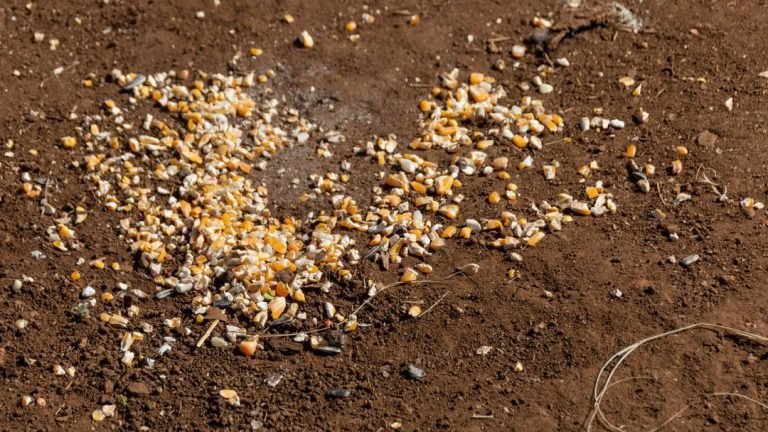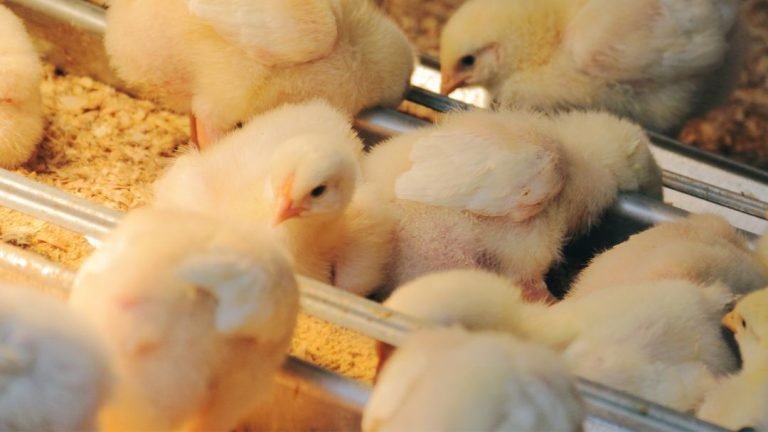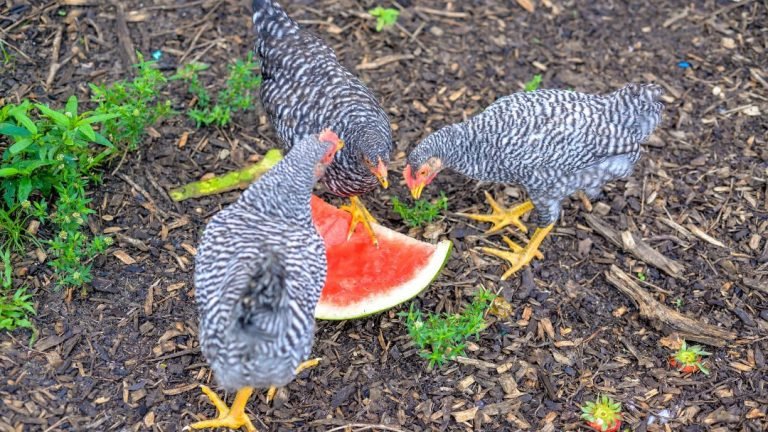Chick starter is a highly notorious food formulated for baby chicks, whereas layer feed is fed to laying hens. Both types of food are prepared with different ingredients to fulfill the nutritional requirements of some particular chickens.
The primary difference between chick starter vs layer feed is its protein concentration. Starter feed has 20-22% protein, whereas layer feed contains 16-18% protein. Starter feed is suitable for baby chicks aged between 0-8 weeks. But layer feed is ideal for laying hens aged more than 18 weeks of old.
What Is The Difference Between Chick Starter And Layer Feed?
Let’s take a look at the ingredients of chick starter feed and layer feeds:
| Specifications | Chick Starter | Layer Feed |
|---|---|---|
| Protein | 20-22% | 16-18% |
| Calcium | 0.08% to 1% | 4% |
| Vitamin D | 800-1000 IU/kg | 1500-2000 IU/kg |
| Vitamin A | 8000-10,000 IU/kg | 5000-8000 IU/kg |
| Vitamin E | 50 IU/kg | 20-30 IU/kg |
| Methionine | 0.45% | 0.3% |
| Lysine | 1.2% | 0.7-0.9% |
| Zinc | 40-60 mg/kg | 80-120 mg/kg |
| Texture | Fine crumble or mash | Pellets or crumble |
| Feeding Duration | 0 to 6-8 weeks old | After 18 weeks old |

01. Protein
Chick starter has 20% to 22% of protein. Baby chicks need more protein to grow new feathers on their body.
Plus, additional protein will contribute to properly developing size, muscle, and organs.
Many high-quality starter feeds contain dried mealworms with around 53 % protein.
Other protein-rich treats are insects, seeds, sprouts, dried soldier fly larvae, etc.
In contrast, layer feed contains around 16% to 18% protein.
Laying hens need this particular percentage of protein for better egg production and body function.
Many layer feed contains Sunflower seeds that have around 25% protein.
Some laying food includes fish or fish meal. Hens will receive around 61% to 72% protein from the fish proportion.
02. Calcium
Chicken starter feed contains only 0.8% to 1% of calcium.
Baby chicks don’t need too much calcium as they don’t lay eggs.
Besides, feeding too much calcium can be a serious problem. It may harm their kidney permanently, which can lead to death.
Experts generally recommend keeping the calcium intake within 1% for baby chicks. Chickens under 18 weeks should not be fed more than 1% of calcium.
On the other hand, layer feed contains around 4% of calcium.
Feeding a higher amount of calcium is necessary for laying hens to make their eggshells strong and sturdy within 48 hours.
After all, an eggshell contains around 90% calcium. The remaining 10% is covered by magnesium, phosphorous, manganese, zinc, and vitamin D3.
Laying hens need approximately 4 to 5 grams of calcium per day.
03. Vitamin D
Chicken starter feed contains approximately 800-1000 IU/kg of vitamin D.
Baby chicks need a good amount of vitamin D to optimize mineral digestibility, immunity indices, and bone health.
Otherwise, it will cause rickets, resulting in leg and beak deformities.
Vitamin D also helps baby chicks to absorb calcium and phosphorus.
In contrast, layer feed has a higher amount of vitamin D, which is around 1500-2000 IU/kg.
They need vitamin D for embryonic development. It stimulates yolk calcium mobilization for baby chicks.
Besides, Vitamin D improves the overall eggshell quality. A lack of vitamin D may adversely affect egg production. It will also cause calcium deficiency.
Hence, laying hens need a higher amount of vitamin D for optimal growth and better egg and shell quality. It contributes to their overall reproduction.
04. Vitamin A
Chick starter feed contains around 8000-10,000 IU/kg of vitamin A.
They need more Vitamin A than adult chickens for average growth and to keep their epithelial cells in good condition.
Besides, it improves their feed utilization, bone development, and vision.
A decent amount of vitamin A is necessary to make their body resistant to diseases. Baby chicks usually show the symptoms of vitamin deficiency within 3 to 4 weeks.
On the other hand, layer feed has approximately 5000-8000 IU/kg of vitamin A.
Laying hens need vitamin A to improve their yolk color and eggshell quality.
Vitamin A plays a crucial role, especially for aged laying hens in improving their eggshell gland oxidative status.
They may be heavily parasitized if they lack a significant amount of Vitamin A in their diet.
05. Vitamin E
Chick starter feed contains 50 IU/kg of vitamin E.
Compared to layer feed, starter feed has a higher amount of vitamin E to ensure normal integrity of the central nervous and muscular systems.
A lack of vitamin E in baby chicks may lead to ‘crazy chick disease’ or encephalomalacia.
You will see such symptoms within 15-30 days of age.
But layer feed has only 20-30 IU/kg of vitamin E to support laying hens for reproduction.
Other than these, it improves their nerves’ functioning and immune response. Their fertility rate, hatchability, postnatal growth, sperm motility, and conception rate will increase too.
In addition, Vitamin E in layer feed improves the α-tocopherol concentration of the egg yolk and serum.
06. Methionine
Chicken starter feed has around 0.45% of Methionine for optimal growth and efficiency.
It helps baby chicks to absorb amino acids in the intestines.
This ingredient is essential for cell proliferation. It aids in increasing the number of cells through cell growth and cell division.
In contrast, layer feed contains around 0.3% of Methionine.
Layer feed is usually fed to laying hens. They don’t need as much Methionine as meat-based flocks and baby chicks need.
Avoid feeding too much Methionine to laying hens as it may lead to various neurological problems and intellectual disability.
07. Lysine
Chicken starter feed has around 1.2% lysine to balance the nutritional level.
An ideal protein diet won’t be completed without lysine because the ingredient plays a key role in protein synthesis.
It is known as the second limiting amino acid. The main job is decreasing protein degradation in chicks.
The ingredient also helps form collagen, an essential substance for bones and connective tissues.
Oppositely, layer feed contains around 0.7-0.9% of lysine to ensure egg and body protein synthesis.
A lack of lysine will result in a loss of egg production, affecting various internal egg quality parameters.
In addition, a balanced lysine intake will better contribute to egg weight, egg mass, Haugh unit, and FCR.
08. Zinc
Chick starter feed contains approximately 40-60 mg/kg of zinc.
Baby chicks need a good amount of zinc for feather development, enzyme structure and function, and bone development.
It should be around 0.012% to 0.018% based on the weight of the baby chick.
Besides, it helps small chickens to form insulin and numerous enzymes in their body.
A lack of zinc in baby chicks may lead to problems such as labored breathing, accelerated respiratory rates, etc.
Contradictorily, layer feed has more zinc than starter feed to support hens for better reproduction.
It is around 80-120 mg for each kilogram of layer feed. Zinc is essential for laying hens to cause minimal stress in their production system and improve their immune system.
More importantly, it increases the strength of eggshells in older hens and better eggshell deposition.
09. Texture
Chicken starter feed has a fine crumble or mash texture.
This type of food is smaller in size. They can effortlessly and quickly eat.
Besides, it ensures consistent nutrition in every bite
The best part is that it is easy to digest. Baby chicks don’t feel uncomfortable eating them.
However, layer feed usually has pellets or crumble texture.
They are small, uniform, and tube-shaped pieces of food.
Laying hens can eat them won’t cause any problems in their digestive system.
10. Feeding Duration
Chicken starter feed is mainly suitable for baby chicks
You have to serve this food from the very first day after they are born.
Chick starter feed needs to continue for up to 6 to 8 weeks. Sometimes, you may have to serve the food for ten weeks if the baby chicks are growing slowly.
But, it is a good rule of thumb to avoid feeding after six weeks if they have enough natural growth.
On the flip side, layer feed is perfect for hens who reach 18 weeks old. Make sure to serve layer feed once their first egg arrives.
However, avoid completely transitioning to layer feed suddenly. It may hurt their stomach.
Increase the layer feed intake and reduce the grower feed intake.
Once they become accustomed to the layer feed, you can stop feeding grower feed.
Does Chick Starter Provide More Energy Than Layer Feed?
Chick Starters have higher energy levels to support young chicks’ rapid growth and development.
They need a more nutrient-dense diet to replenish the nutrients and minerals lost during extreme stress.
A baby chick needs around 130-160 calories per day. But, the calorie intake needs to be higher during the winter season.
In contrast, layer feed has moderate energy levels to support egg production without promoting excessive weight gain.
Laying hens need around 260 calories of metabolizable energy per day during the summer months.
However, metabolizable calories can be as high as 340 per day during the winter months.
Can You Feed Layer Feed To Baby Chicks?
Feeding layer feed to baby chicks is prohibited as it contains a higher amount of calcium.
The kidneys of younger chickens might be damaged from excessive consumption of calcium.
It will also affect its lifetime egg production and shorten a bird’s lifespan.
Chicken keepers must wait at least 18 weeks to feed layer feed to chickens.
Besides, layer feed contains less protein, vitamin A, vitamin E, and lysine.
It can significantly reduce the overall growth of baby chicks than the potential.
In addition, layer feed is not formulated to be easier for young chicks to digest, as their digestive systems are not yet fully developed.
Can You Feed Starter Feed To Laying Hens?
Feeding starter feed to laying hens is possible. But it may affect their overall health negatively.
Starter feed contains around 20% to 22% of protein, whereas layer feed has 16% to 18% of protein.
Feeding laying hens a starter feed may result in nutrient deficiencies or excesses. It may also lead to decreased egg production.
Eating excessive protein, in the long run, may lead to respiratory distress and problems in the trachea and eyes. In some cases, it causes kidney and liver failure.
However, you can serve starter feed occasionally by mixing it with layer feed during extremely cold conditions.
Wrapping UP
Like humans, chickens also need food for maximum performance and good health. Chicken feed needs to be appropriately balanced with energy, protein, essential amino acids, minerals, and vitamins. It will support them in their optimal growth.
However, chickens don’t need the same type of food throughout their lifecycle. Baby chicks need starter feed until they reach 8 to 10 weeks old. Laying hens need layer feed for better egg production. Now, you know the clear difference between chick starter vs layer feed.






